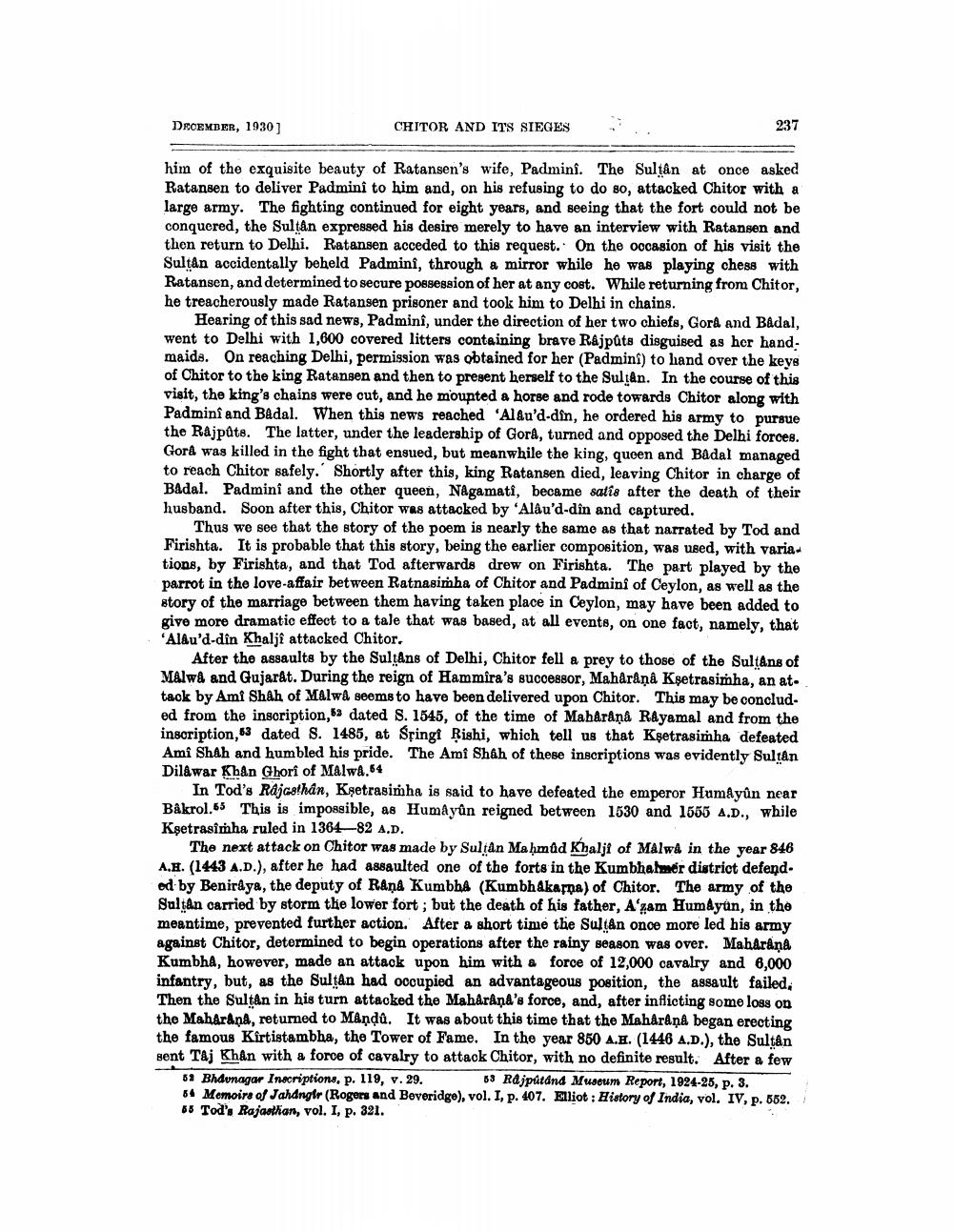________________
DECEMDER, 1930)
CHITOR AND ITS SIEGES
237
him of the exquisite beauty of Ratansen's wife, Padmini. The Sultan at once asked Ratansen to deliver Padmini to him and, on his refusing to do so, attacked Chitor with a large army. The fighting continued for eight years, and seeing that the fort could not be conquered, the Sultan expressed his desire merely to have an interview with Ratansen and then return to Delhi. Ratansen acceded to this request. On the cocasion of his visit the Sultân accidentally beheld Padmini, through a mirror while he was playing chess with Ratansen, and determined to secure possession of her at any cost. While returning from Chitor, he treacherously made Ratansen prisoner and took him to Delhi in chains.
Hearing of this sad news, Padmini, under the direction of her two chiefs, Gord and Badal, went to Delhi with 1,600 covered litters containing brave Rajpats disguised as her handmaids. On reaching Delhi, permission was obtained for her (Padmini) to hand over the keys of Chitor to the king Ratansen and then to present herself to the Sultan. In the course of this visit, the king's chains were cut, and he mounted a horse and rode towards Chitor along with Padmini and Badal. When this news reached 'Alau'd-din, he ordered his army to pursue the Rajputs. The latter, under the leadership of Gora, turned and opposed the Delhi forces. Gora was killed in the fight that ensued, but meanwhile the king, quoen and Badal managed to reach Chitor safely.' Shortly after this, king Ratansen died, leaving Chitor in charge of Badal. Padmini and the other queen, N&gamati, became satis after the death of their husband. Soon after this, Chitor was attacked by 'Alau'd-dîn and captured.
Thus we see that the story of the poem is nearly the same as that narrated by Tod and Firishta. It is probable that this story, being the earlier composition, was used, with variations, by Firishta, and that Tod afterwards drew on Firishta. The part played by the parrot in the love-affair between Ratnasimha of Chitor and Padmini of Ceylon, as well as the story of the marriage between them having taken place in Ceylon, may have been added to give more dramatic effect to a tale that was based, at all events, on one fact, namely, that 'Alau'd-dîn Khaljî attacked Chitor,
After the assaults by the Sultans of Delhi, Chitor fell a prey to those of the Sultans of MAlwi and Gujarat. During the reign of Hammira's successor, Mahâråņa Kşetrasimha, an at. tack by Ami Shah of Malwa seems to have been delivered upon Chitor. This may be conclud. ed from the inscription,52 dated S. 1545, of the time of Maharaņå Rayamal and from the inscription, 63 dated $. 1485, at Spingi Rishi, which tell us that Kşetrasimha defeated Ami Shah and humbled his pride. The Ami Shah of these inscriptions was evidently Sultan Dilawar Khan Ghori of Malwa.54
In Tod's Rajasthan, Kgetrasimha is said to have defeated the emperor Humayun near Bâkrol.65 This is impossible, as Humâyûn reigned between 1530 and 1555 A.D., while Kşetrasimha ruled in 136482 A.D.
The next attack on Chitor was made by Sultan Mahmad Khaljf of Malwa in the year 846 A.H. (1443 A.D.), after he had assaulted one of the forts in the Kumbhalmer district defend. ed by Benir4ya, the deputy of Rana Kumbhá (Kumbh Akarna) of Chitor. The army of the Sultan carried by storm the lower fort ; but the death of his father, A'zam Humayun, in the meantime, prevented further action. After a short time the Sultan once more led his army against Chitor, determined to begin operations after the rainy season was over. Maharana Kumbha, however, made an attack upon him with a foroe of 12,000 cavalry and 6,000 infantry, but, as the Sultan had occupied an advantageous position, the assault failed. Then the Sultan in his turn attacked the Mahârând's force, and, after inflicting some loss on the MaharAnA. returned to Mandų. It was about this time that the Maharana began erecting the famous Kirtistambha, the Tower of Fame. In the year 850 A.H. (1446 A.D.), the Sultan gent T&j Khan with a force of cavalry to attack Chitor, with no definite result. After a few
01 Bhavnagar Inscriptions, p. 119, v. 29. 53 Rajputand Museum Report, 1924-26, p. 3. 64 Memoirs of Jahangir (Rogers and Beveridge), vol. I, p. 407. Elliot : History of India, vol. IV, p. 562. 55 Tod's Rajasthan, vol. I, p. 321.




